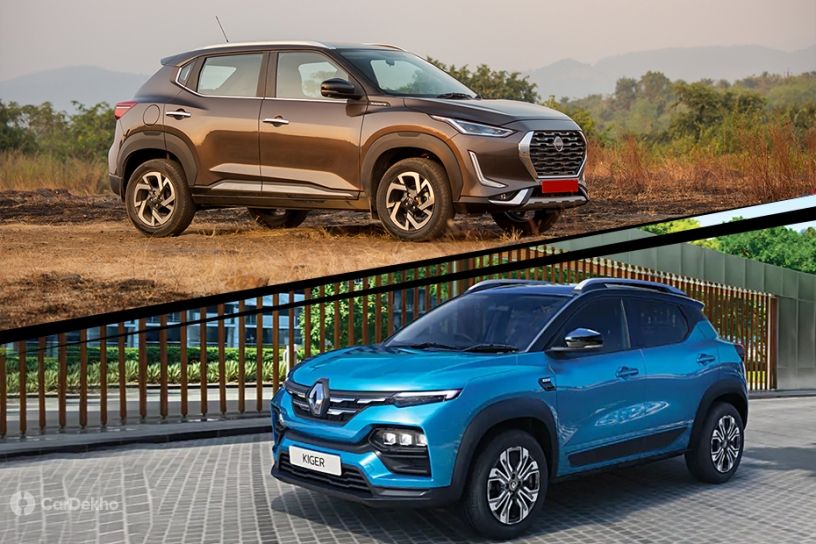How Does The Renault Kiger Compare To The Nissan Magnite? Know These 10 Differences
Modified On Jan 29, 2021 06:16 PM By Tarun
- Write a comment
Though the Renault Kiger shares its platform, engines, and gearbox options with the Nissan Magnite, there are still some distinct differences

Renault premiered the Kiger in India, making it the ninth SUV in the sub-compact segment. The Kiger, unveiled in a production-ready avatar ahead of its launch in March, shares its platform with the Nissan Magnite. Both get a 1.0-litre naturally aspirated petrol and a 1.0-litre turbocharged petrol engine. Sure, the features are similar, yet the two are different in their own ways. The Magnite’s aggressive pricing and value-for-money packaging have contributed to its success. The bookings look generous, and something similar is expected with the Renault Kiger as well.
That out of the way, here are the top 10 differences between both the offerings:
Kiger gets a bigger boot


The Kiger boasts a boot capacity of 405 litres, which is 69 litres more than the Magnite’s. In fact, the Renault SUV offers best-in-segment boot space, which can be further extended to 879 litres with the second row folded.
Magnite gets connected car technology

The Magnite comes with connected car technology, mostly related to telematics. It is equipped with features like geofencing and vehicle tracking, and displays vehicle status, vehicle health, and other information through a smart watch-integrated mobile app. In contrast, the Kiger does not offer connected car technology.
Kiger is shorter and narrower, but taller than the Magnite


The Renault SUV is 3,991mm long and 1750mm wide. In comparison, the Magnite is 3,994mm long and 1,758mm wide. However, the Kiger is 1600mm tall, 28mm more than the Magnite standing at 1572mm. Both have the same 2500mm-wheelbase. These little contrasts are due to the differences in their designs.
An automatic gearbox for the naturally aspirated 1.0-litre petrol engine

The Magnite is offered with two engines -- a 1.0-litre naturally aspirated (N.A) and a 1.0-litre turbo. While the N.A motor produces 72PS and 96Nm, the turbo engine produces 100PS and 160Nm. Both the SUVs are offered with a 5-speed manual and a CVT for the turbo motor. While the Magnite only gets a manual stick for the N.A engine, the Kiger receives an additional 5-speed AMT. It would be a good choice for someone looking for an automatic option and not keen on the more powerful 100PS engine.
Kiger gets up to four airbags

The Magnite has dual front airbags as standard, whereas the Kiger gets up to four airbags with the additional front side airbags. That means more safety for the front passengers. Lest we forget, the India-made Magnite recently scored 4 stars in the ASEAN NCAP crash test, and the Kiger is also expected to get a similar rating.
Kiger gets three drive modes

The Kiger is offered with three drive modes - Normal (City), Eco and Sport. The engine mapping and the gearbox are tuned differently for all the three modes. The Kiger features a cool knob to shift between the modes. The Magnite only gets Sports mode along with the Normal mode.
Magnite gets a 360-degree camera

Nissan provides the Magnite with a 360-degree camera, a segment-first feature. This is exclusive to the top-spec variant. The Kiger, meanwhile, gets a regular rear parking camera.
Magnite gets tyre pressure monitoring system (TPMS)

The Magnite comes with TPMS, while the Kiger does not. However, the TPMS just lets you know if the tyre is deflated or the pressure is lower than the pre-set range, and not the actual PSI rating.
Magnite gets a better audio and speaker setup


The Renault Kiger gets an ARKAMYS sound system with four speakers and four tweeters. On the other hand, the Magnite gets a more premium JBL 6-speaker audio system (optional).
Kiger boasts of more storage capacity inside the cabin

The Kiger features a twin-glove-box setup like the Triber MPV, along with a slider-type centre storage console. It gets cabin storage capacity of up to 29 litres, which is more than what we get on the Magnite.
10 out of 10 found this helpful















